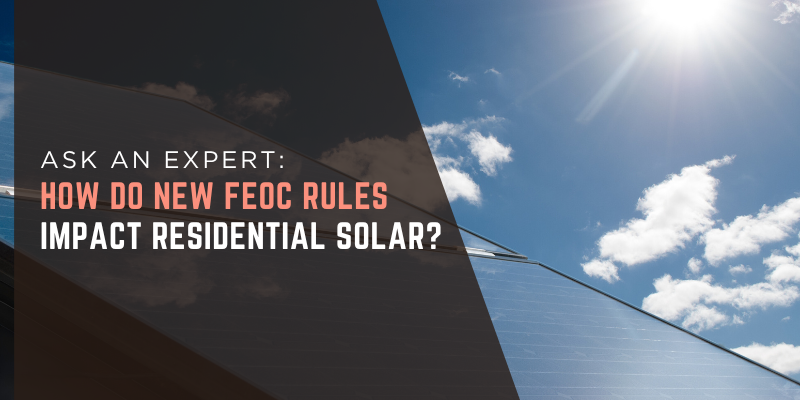What in the FEOC is Going On? Solar and “Foreign Entity of Concern” Rules in the OBBB
With Trump’s One Big Beautiful Bill signed into law, there’s been a lot of discussion—and confusion—about what “FEOC” is, and how it will impact the US solar industry.
What is FEOC?
FEOC is an acronym meaning “Foreign Entity of Concern” and is the DC way of saying companies that have ties to North Korea, Russia, Iran, or China. Inserting FEOC prohibitions and language in the One Big Beautiful Bill now gives legislatures a vehicle to place future restrictions on companies with ties to those countries without going line by line and modifying text.
For the purposes of the solar industry, the only country amongst the FEOC group that has any consequence is China, which controls a significant portion of solar manufacturing. Reviewing import data highlights that the US receives next to no solar modules or cells from China, but rather from Chinese companies operating in other countries around the world. And, more importantly, a lot of Chinese companies have established US manufacturing.
One of the fundamental goals of the FEOC restrictions is to minimize US taxpayer support of Chinese companies.
How FEOC Regulations Work for Solar
There are two sides to FEOC regulations. Think of them as supply (manufacturing) and demand (project-level tax credits).
The demand restrictions are intended to inhibit companies with ties to Chinese entities—which is defined by assessing executive and board structure, debt and equity holders, IP holders, and principal place of business—from monetizing the production tax credits issued to companies that make solar components in the US. It’s not as simple as a company being a US LLC, S-Corp or other registered entity with a local President and Exec team. Thorough due diligence must be done for the US Treasury to make a determination as to whether or not a company passes or fails a FEOC test.
The other side of the equation is the supply side, which makes projects ineligible for monetizing the tax credits if the project itself is owned or invested in by a FEOC entity (beyond a certain threshold), or if the project exceeds a certain allowance of FEOC “Material Assistance,” which is effectively components and sub components sourced from FEOC entities at a project level. These thresholds vary for solar and storage projects.
Again, here, there are a lot of details that require examination. Beyond a superficial scan of a data sheet, we’ll likely see manufacturers begin to produce “Reliance Letters” indicating their audited material assistance ratios. These FEOC restrictions on the demand side don’t take effect until 2026.
How Do FEOC Regulations Impact Residential Solar?
The homeowner tax credit claimed under section 25D is free and clear of any FEOC restrictions. Homeowners should be mindful, however, of who makes their technology and whether or not they’ll be around to service it in the unlikely event of a warranty claim or issue in the future. Between FEOC restrictions and trade barriers, it’s best to work with a US manufacturer with no ties to China or a long-standing importer that has no ties to China. This is why Solar.com Energy Advisors typically recommend panels from Q Cells, REC, or Silfab.
For projects beginning next year, the third-party owner will be responsible for assessing the FEOC restrictions and running due diligence so homeowners are relieved of the burden of trying to navigate the FEOC maze.






